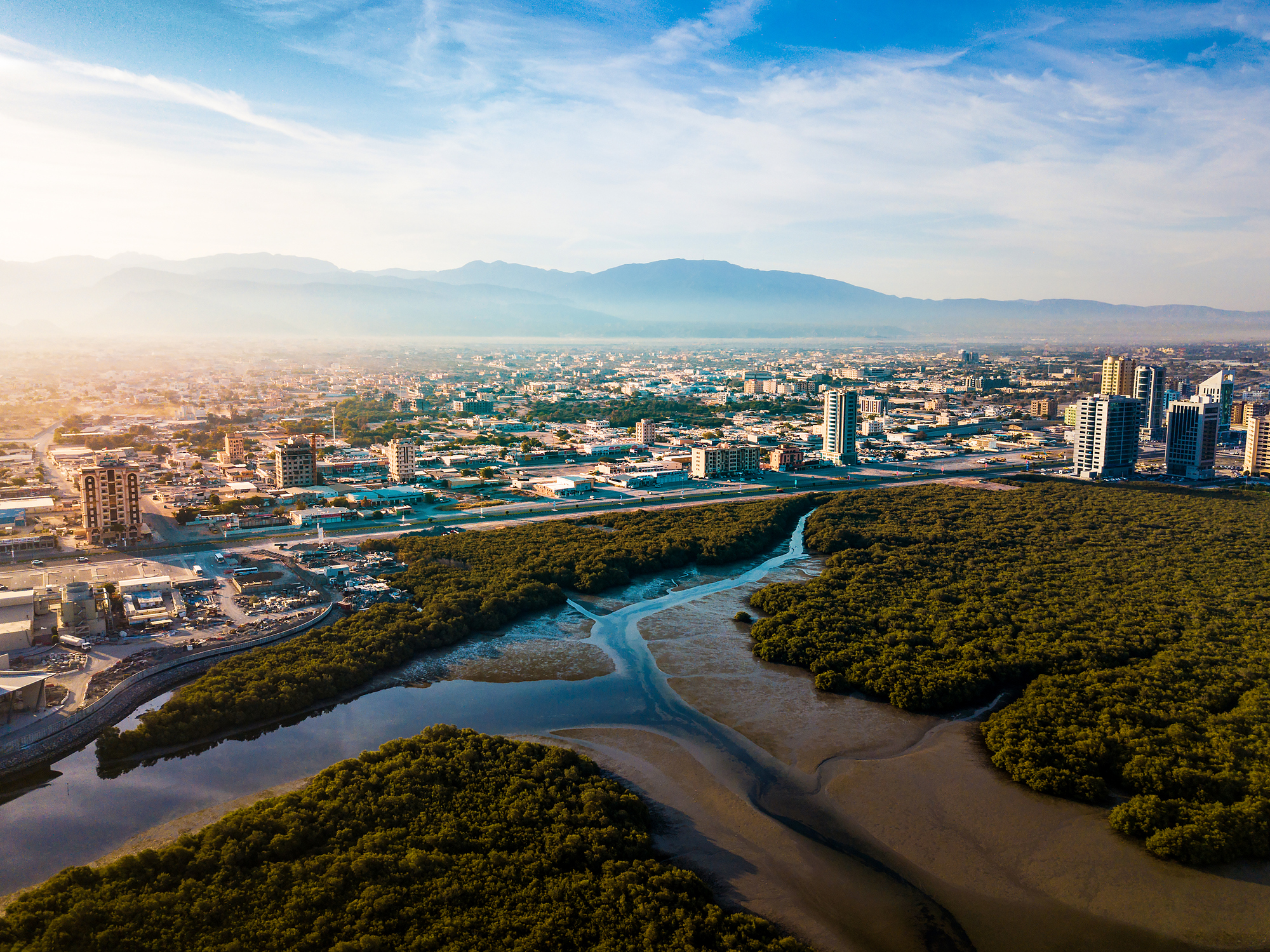| THE EMIRATE IN MODERN TIMES | ||||
|---|---|---|---|---|
| Heritage and Culture | Society | Healthcare and Education | Economy and Industry | |

Ras Al Khaimah’s rich history, heritage and culture can be seen in full in the other sections of this website. Its heritage also comes from its unique geographical features – mountains, coastal beaches, mangroves and the desert – along with its strategic location at the mouth of the Arabian peninsula. With history this old comes traditions and artforms that are passed on from one generation to the next. These can be seen in the emirate’s exquisite folklore, folk music and dance that express the local social, ethical and aesthetic values.
Ras Al Khaimah is mainly a tribal society, with most of its local population belonging to different tribes, be it mountain tribes, sea tribes and desert tribes. Each of these main tribes has several tribes under its ‘family name’, and they can be differentiated from one another due to their dialects. The people of Ras Al Khaimah, including the various tribes and the significant historical figures, have been a part of the rich history of the Emirate.
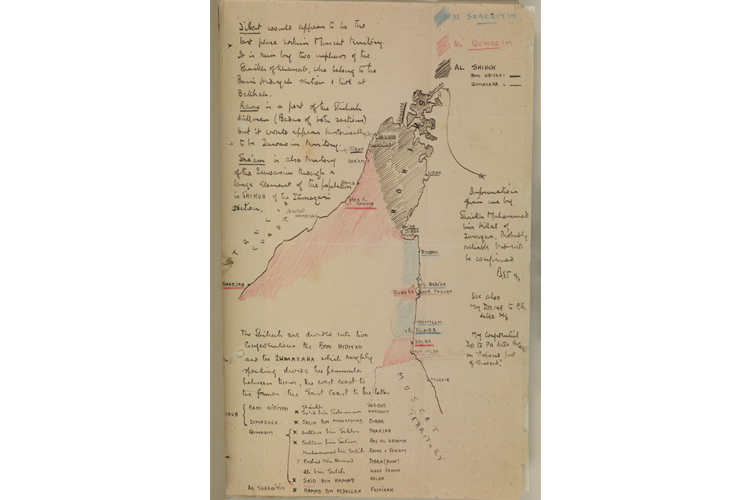 A map of the Musandam Peninsula by Bertram Thomas, showing the territories of the Trucial Chiefs, 1928. © Qatar National Library.
Historically, it is the mountain tribes that have been the most distinct, particularly in relation to language. The most famous of these is the Shihuh, or Al Shehhi. Its dialect has fascinated travellers and scholars for centuries, including the British diplomat and explorer Bertram Thomas, who visited the Musandam Peninsula in 1928. Writing of his travels, Thomas noted that it was their “strange tongue which has baffled and confused travellers”. Thomas, who became the first documented Westerner to cross the Rub’ al Khali (the Empty Quarter), believed their language was “almost exclusively a compound of corrupt Persian and Arabic”. He also stated that “their Arabic – they are bilingual – is a sing-song Arabic but comparatively pure as Arabic goes in this part of Arabia and certainly without a trace of Persian accent.”
When Julian Walker was undertaking his delimitation survey in the 1950s, he too reported that the Shihuh were divided into two main sections – the Bani Shatair and the Bani Hadiyah – and speak “their own dialect of Arabic with some non-Arab words interspersed in it”. Even today, the tribes that constitute the Shihuh of Ras Al Khaimah continue to speak in a dialect that other tribes find difficult to understand. Other mountain tribes such as the Habus, who originally formed a section of the Bani Hadiyah, and the Al Dhuhoori also speak the Shehhi dialect.
The desert tribes include the Al Khatiri, Al Shamsi and Al Kitbi, while those along the coast include the Za’ab (the traditional inhabitants of the now abandoned pearling and fishing town of Jazirat al-Hamra), Al Tunaij and Al Ali. The culture of all these tribes varies, depending on whether they are from the mountains, the desert or the sea, and encompasses everything from music and dance to poetry and folklore. Dance in particular is of great communal importance, with traditional dances such as Al Wahabiyya, Al-Ayyala and Razfa performed on special occasions such as weddings and feast days. Passed down from generation to generation, these practices continue to express the social, ethical and aesthetic values of their communities, as does the art of storytelling.
At the heart of spoken word lies Nabati and Taghrouda poetry, the origins of which stretch back centuries. A sometimes-hypnotising combination of lyricism, wisdom and the timeless art of storytelling, both forms are characterised by their use of colloquial dialects and, in the case of Taghrouda, poetic duels between two people. One of the most famous Nabati practitioners was Al Majidi Bin Dhaher, a folk poet who lived in Ras Al Khaimah during the late sixteenth and early seventeenth centuries. His work captured both the hardship of the desert and the beauty of the sea, and through his words he immortalised prominent Bedu tribes and recorded their stories. Over time his poetry would transform into folklore.
That folklore continues in the form of poetry, but also in proverbs, songs and folk tales. The latter includes short stories known as ‘kharrufa’ (meaning ‘fictitious tale’), historical narratives called ‘salfah’, and short sung folktales known as ‘khrairifa’. Traditional games like Al Yarba, Al Gabba and Al Zaboot are still played, although not as widely as they once were, and food remains a central part of Ras Al Khaimah’s cultural heritage. Traditional cuisine includes everything from machboos (rice and meat seasoned with spices, onions, tomatoes, and dried lemon), to kami (dried de-fatted milk curds) and harees (small pieces of shredded meat mixed with wheat and water). In the recent past, large trays of home-made bread known as regag would be passed around in the street on Thursdays and Fridays, while meals would be prepared for the entire neighbourhood during weddings and other special occasions.
Given the importance of pearling, the songs and traditions of the sea are especially cherished. Every year pearl divers would leave their homes for the four-month pearling season, leaving behind their wives and families. When they were away the women would sing of their men’s return, while the men sang as they rowed or raised the sails. They lived in towns such as Al Jazeera Al Hamra, whose traditional coral-stone architecture, as well as its fortress, souks, mosques and housing, form the only remaining authentic seafaring town in the UAE. Now home to the annual Ras Al Khaimah Fine Arts Festival, the town has been the subject of restoration work since 2015, when Ras Al Khaimah’s Department of Antiquities and Museums initiated the Al Jazeera Al Hamra Conservation Project. Since then, the focus has been on turning the town into a national heritage site, complete with workshops, museum and visitor centre.
A map of the Musandam Peninsula by Bertram Thomas, showing the territories of the Trucial Chiefs, 1928. © Qatar National Library.
Historically, it is the mountain tribes that have been the most distinct, particularly in relation to language. The most famous of these is the Shihuh, or Al Shehhi. Its dialect has fascinated travellers and scholars for centuries, including the British diplomat and explorer Bertram Thomas, who visited the Musandam Peninsula in 1928. Writing of his travels, Thomas noted that it was their “strange tongue which has baffled and confused travellers”. Thomas, who became the first documented Westerner to cross the Rub’ al Khali (the Empty Quarter), believed their language was “almost exclusively a compound of corrupt Persian and Arabic”. He also stated that “their Arabic – they are bilingual – is a sing-song Arabic but comparatively pure as Arabic goes in this part of Arabia and certainly without a trace of Persian accent.”
When Julian Walker was undertaking his delimitation survey in the 1950s, he too reported that the Shihuh were divided into two main sections – the Bani Shatair and the Bani Hadiyah – and speak “their own dialect of Arabic with some non-Arab words interspersed in it”. Even today, the tribes that constitute the Shihuh of Ras Al Khaimah continue to speak in a dialect that other tribes find difficult to understand. Other mountain tribes such as the Habus, who originally formed a section of the Bani Hadiyah, and the Al Dhuhoori also speak the Shehhi dialect.
The desert tribes include the Al Khatiri, Al Shamsi and Al Kitbi, while those along the coast include the Za’ab (the traditional inhabitants of the now abandoned pearling and fishing town of Jazirat al-Hamra), Al Tunaij and Al Ali. The culture of all these tribes varies, depending on whether they are from the mountains, the desert or the sea, and encompasses everything from music and dance to poetry and folklore. Dance in particular is of great communal importance, with traditional dances such as Al Wahabiyya, Al-Ayyala and Razfa performed on special occasions such as weddings and feast days. Passed down from generation to generation, these practices continue to express the social, ethical and aesthetic values of their communities, as does the art of storytelling.
At the heart of spoken word lies Nabati and Taghrouda poetry, the origins of which stretch back centuries. A sometimes-hypnotising combination of lyricism, wisdom and the timeless art of storytelling, both forms are characterised by their use of colloquial dialects and, in the case of Taghrouda, poetic duels between two people. One of the most famous Nabati practitioners was Al Majidi Bin Dhaher, a folk poet who lived in Ras Al Khaimah during the late sixteenth and early seventeenth centuries. His work captured both the hardship of the desert and the beauty of the sea, and through his words he immortalised prominent Bedu tribes and recorded their stories. Over time his poetry would transform into folklore.
That folklore continues in the form of poetry, but also in proverbs, songs and folk tales. The latter includes short stories known as ‘kharrufa’ (meaning ‘fictitious tale’), historical narratives called ‘salfah’, and short sung folktales known as ‘khrairifa’. Traditional games like Al Yarba, Al Gabba and Al Zaboot are still played, although not as widely as they once were, and food remains a central part of Ras Al Khaimah’s cultural heritage. Traditional cuisine includes everything from machboos (rice and meat seasoned with spices, onions, tomatoes, and dried lemon), to kami (dried de-fatted milk curds) and harees (small pieces of shredded meat mixed with wheat and water). In the recent past, large trays of home-made bread known as regag would be passed around in the street on Thursdays and Fridays, while meals would be prepared for the entire neighbourhood during weddings and other special occasions.
Given the importance of pearling, the songs and traditions of the sea are especially cherished. Every year pearl divers would leave their homes for the four-month pearling season, leaving behind their wives and families. When they were away the women would sing of their men’s return, while the men sang as they rowed or raised the sails. They lived in towns such as Al Jazeera Al Hamra, whose traditional coral-stone architecture, as well as its fortress, souks, mosques and housing, form the only remaining authentic seafaring town in the UAE. Now home to the annual Ras Al Khaimah Fine Arts Festival, the town has been the subject of restoration work since 2015, when Ras Al Khaimah’s Department of Antiquities and Museums initiated the Al Jazeera Al Hamra Conservation Project. Since then, the focus has been on turning the town into a national heritage site, complete with workshops, museum and visitor centre.
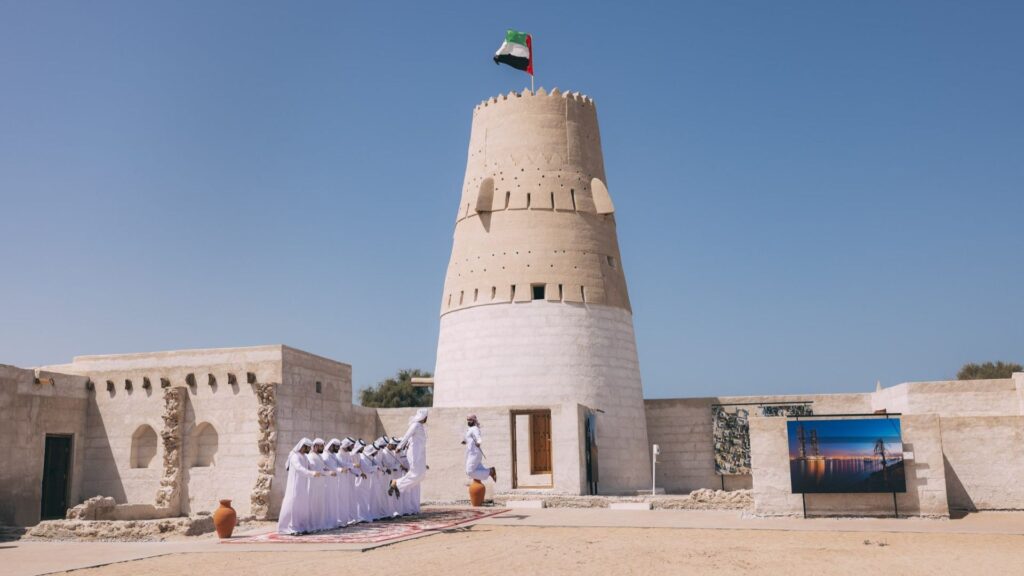 The 11.9-metre-high tower at the Al Jazeera Al Hamra is a classic example of a traditional defensive building. © Ras Al Khaimah Tourism Development Authority.
Other significant heritage sites include Dhayah Fort, which was the last point of defence during the British attack of 1819. Sitting atop a conical-shaped hill and overlooking the plain below, it is the only surviving hill-top fort in the UAE. Others include Hudaybah Tower and Falayah, which date back to the war between the British and the Qawasim. The General Peace Treaty was signed in 1820 at Falayah, the favoured summer retreat of the Qawasim. The National Museum of Ras Al Khaimah is also housed in a nineteenth-century fortification that was built on the grounds of a fort destroyed by the British. The building served as the residence of the Qawasim family until 1964 before becoming a police station and a prison. It was finally converted into the museum in 1987.
The 11.9-metre-high tower at the Al Jazeera Al Hamra is a classic example of a traditional defensive building. © Ras Al Khaimah Tourism Development Authority.
Other significant heritage sites include Dhayah Fort, which was the last point of defence during the British attack of 1819. Sitting atop a conical-shaped hill and overlooking the plain below, it is the only surviving hill-top fort in the UAE. Others include Hudaybah Tower and Falayah, which date back to the war between the British and the Qawasim. The General Peace Treaty was signed in 1820 at Falayah, the favoured summer retreat of the Qawasim. The National Museum of Ras Al Khaimah is also housed in a nineteenth-century fortification that was built on the grounds of a fort destroyed by the British. The building served as the residence of the Qawasim family until 1964 before becoming a police station and a prison. It was finally converted into the museum in 1987.
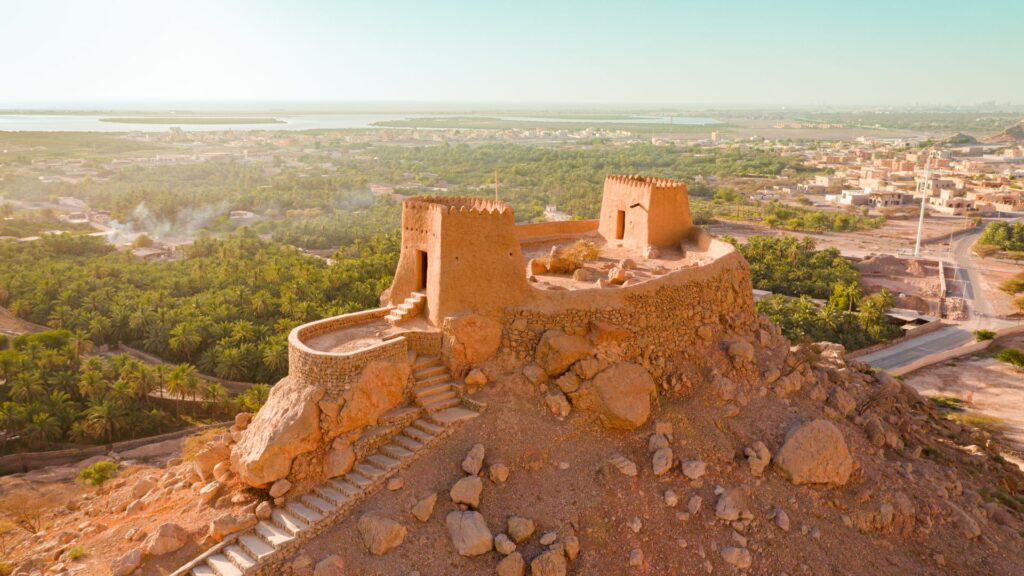 Dhayah Fort in Ras Al Khaimah. © Ras Al Khaimah Tourism Development Authority
Dhayah Fort in Ras Al Khaimah. © Ras Al Khaimah Tourism Development Authority
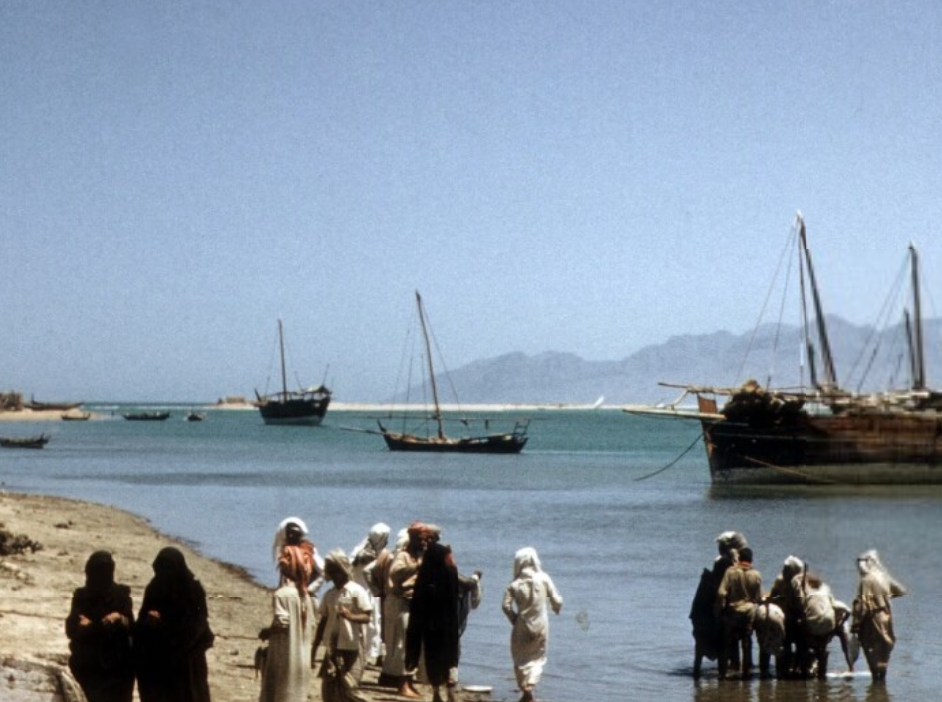 A photograph of the Ras Al Khaimah Creek from 1960. © National Archives, UAE
An almost identical way of life continued to exist in the years leading up to the union. Many oral history projects have recorded the lives of those who lived in Ras Al Khaimah prior to the formation of the union, including one that was carried out by the Sheikh Saud bin Saqr Al Qasimi Foundation for Policy Research in 2020. It revealed in rich detail the lives of those who inhabited Jazirat al-Hamra prior to its abandonment in 1968. “Whenever a boy reached the age of 15, he would be responsible for himself,” remembered Ibrahim Mousa Al Zaabi. “My grandfather had to become a diver for a fisherman at the age of 15. Boys would learn at an early age. When I was six or seven years old, my grandfather tied a rock around my leg so that I would learn diving. I had to learn by watching other men so I, too, could become a man.”
The town had a large market where shopkeepers would sell rice, flour and sugar from Dubai or Umm Al Quwain, and the merchants would provide families with everything they needed while the men were away at sea. Every house had two to three stores (rooms), with a winter store facing east to provide sunlight for warmth, and the summer store facing north and windows providing ventilation. In the summer, everybody would leave, heading either to the palm gardens or the cooler mountain climate. Some would head to the east coast and bring back dates from ships, which they would then sell and distribute around their neighbourhood.
“We used to go to Fujairah with my grandfather,” says Al Zaabi. “He had a farm with plenty of palm trees. We would stay for five or six months and then come back, bringing dates on ships. Dates used to be distributed every two days. Every pack of dates had a mark on it. Out of trust between each other, people would go into each house, put the dates down, and leave the house. We used to go to Fujairah on camels loaded with items. It used to take us six to seven days. We would not pack any water because it was available everywhere due to rain.”
Food was very basic. Breakfast consisted of dates and coffee (and maybe some bread), while rice and fish would be served for dinner. Medical care consisted largely of traditional remedies and there was no drinking water. The latter had to be brought in by donkey every day before dawn. Even lanterns were rare. Families would often use masrai – bottles with cotton wicks (the cotton would contain dates and the bottle would contain gas) – for lighting and those who didn’t have electricity would use car batteries to power any electrical devices they might have. There were no telephones either, only a few radios, and when televisions first arrived in the 1960s electricity would be available for only a few hours a day. Travel was by donkey until cars first arrived in the late 1950s, but even then, they were reserved for only the wealthy.
Very few foreigners lived in Ras Al Khaimah up until the 1960s, but by 1975 the population had reached 43,845, of which 29,613 were nationals and 14,232 were foreigners. That number would rapidly increase over the course of the next few decades, hitting 345,000 in 2015. Emiratis continue to account for a sizeable percentage of the population (31 per cent in 2015), but many different nationalities have made Ras Al Khaimah their home. They are dhow builders, electricians, engineers, farmers, fishermen, tailors, merchants, domestic workers, teachers and nurses and contribute to the success of modern Ras Al Khaimah.
When Sheikh Saud bin Saqr Al Qasimi accepted the Visionary Leader of the Year award from Arabian Business in 2018, it was the people that he thanked. “The people of Ras Al Khaimah, both Emiratis and expatriates, all contribute to making the emirate a fantastic place to live, work and visit,” said Sheikh Saud. “I thank the leadership of the UAE, who have created a safe and prosperous home for people from across the globe. Without their vision, the UAE would not be the great country it is today.”
A photograph of the Ras Al Khaimah Creek from 1960. © National Archives, UAE
An almost identical way of life continued to exist in the years leading up to the union. Many oral history projects have recorded the lives of those who lived in Ras Al Khaimah prior to the formation of the union, including one that was carried out by the Sheikh Saud bin Saqr Al Qasimi Foundation for Policy Research in 2020. It revealed in rich detail the lives of those who inhabited Jazirat al-Hamra prior to its abandonment in 1968. “Whenever a boy reached the age of 15, he would be responsible for himself,” remembered Ibrahim Mousa Al Zaabi. “My grandfather had to become a diver for a fisherman at the age of 15. Boys would learn at an early age. When I was six or seven years old, my grandfather tied a rock around my leg so that I would learn diving. I had to learn by watching other men so I, too, could become a man.”
The town had a large market where shopkeepers would sell rice, flour and sugar from Dubai or Umm Al Quwain, and the merchants would provide families with everything they needed while the men were away at sea. Every house had two to three stores (rooms), with a winter store facing east to provide sunlight for warmth, and the summer store facing north and windows providing ventilation. In the summer, everybody would leave, heading either to the palm gardens or the cooler mountain climate. Some would head to the east coast and bring back dates from ships, which they would then sell and distribute around their neighbourhood.
“We used to go to Fujairah with my grandfather,” says Al Zaabi. “He had a farm with plenty of palm trees. We would stay for five or six months and then come back, bringing dates on ships. Dates used to be distributed every two days. Every pack of dates had a mark on it. Out of trust between each other, people would go into each house, put the dates down, and leave the house. We used to go to Fujairah on camels loaded with items. It used to take us six to seven days. We would not pack any water because it was available everywhere due to rain.”
Food was very basic. Breakfast consisted of dates and coffee (and maybe some bread), while rice and fish would be served for dinner. Medical care consisted largely of traditional remedies and there was no drinking water. The latter had to be brought in by donkey every day before dawn. Even lanterns were rare. Families would often use masrai – bottles with cotton wicks (the cotton would contain dates and the bottle would contain gas) – for lighting and those who didn’t have electricity would use car batteries to power any electrical devices they might have. There were no telephones either, only a few radios, and when televisions first arrived in the 1960s electricity would be available for only a few hours a day. Travel was by donkey until cars first arrived in the late 1950s, but even then, they were reserved for only the wealthy.
Very few foreigners lived in Ras Al Khaimah up until the 1960s, but by 1975 the population had reached 43,845, of which 29,613 were nationals and 14,232 were foreigners. That number would rapidly increase over the course of the next few decades, hitting 345,000 in 2015. Emiratis continue to account for a sizeable percentage of the population (31 per cent in 2015), but many different nationalities have made Ras Al Khaimah their home. They are dhow builders, electricians, engineers, farmers, fishermen, tailors, merchants, domestic workers, teachers and nurses and contribute to the success of modern Ras Al Khaimah.
When Sheikh Saud bin Saqr Al Qasimi accepted the Visionary Leader of the Year award from Arabian Business in 2018, it was the people that he thanked. “The people of Ras Al Khaimah, both Emiratis and expatriates, all contribute to making the emirate a fantastic place to live, work and visit,” said Sheikh Saud. “I thank the leadership of the UAE, who have created a safe and prosperous home for people from across the globe. Without their vision, the UAE would not be the great country it is today.”
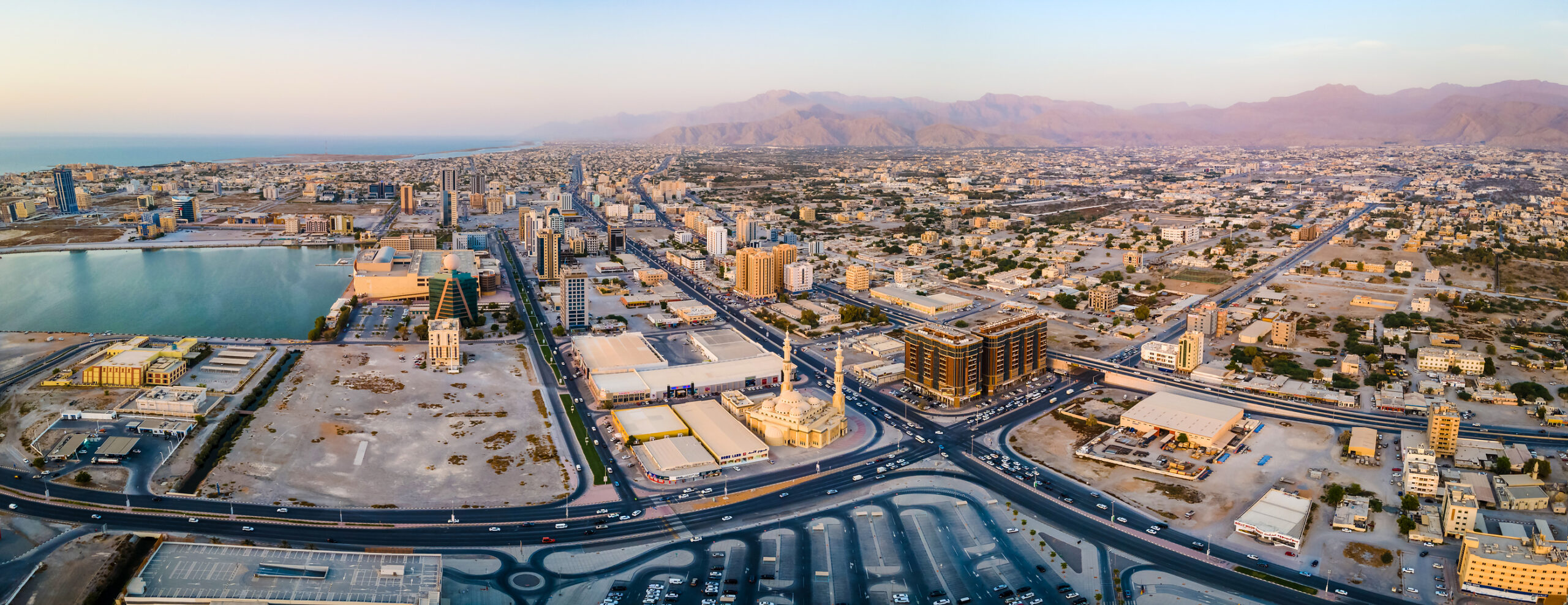 The modern-day Ras Al Khaimah city, where tradition meets urbanity and the city is set against the backdrop of the majestic Hajar Mountains. © Getty Images.
The modern-day Ras Al Khaimah city, where tradition meets urbanity and the city is set against the backdrop of the majestic Hajar Mountains. © Getty Images.
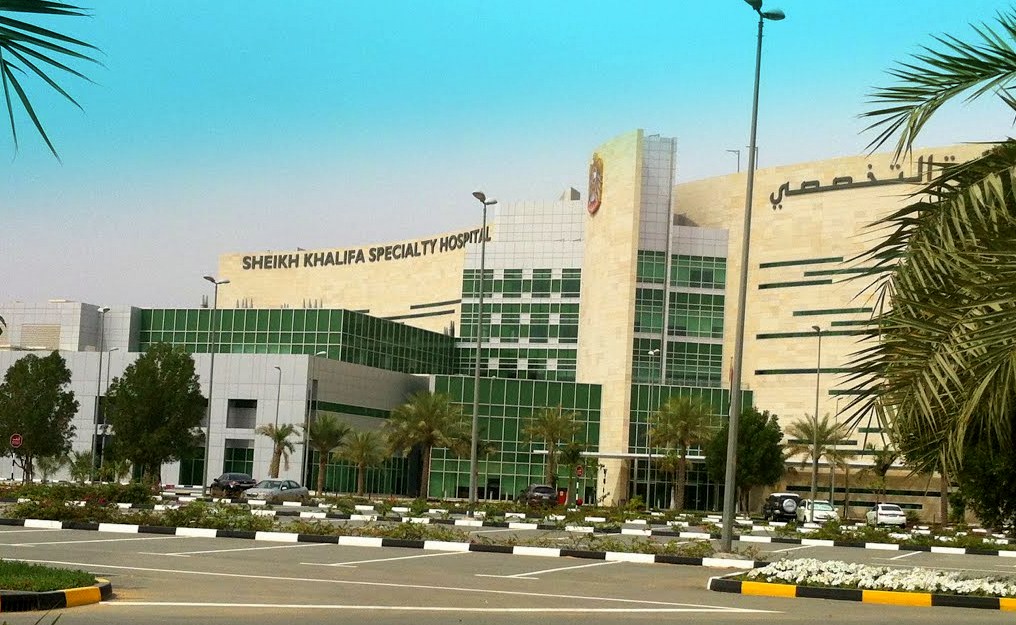 Sheikh Khalifa Specialty Hospital in Ras Al Khaimah.
A similar evolutionary journey applies to the provision of education. Prior to the arrival of the emirate’s first schools, education was the remit of a ‘mutawwa’ (teacher), who either taught at the local mosque or from their home. Children learnt to recite the Quran and, depending on the teacher, may have been taught to read and write and to understand the basics of mathematics. Female teachers would always work from home and their students would be both boys and girls aged between 6 and 10. When a child had learnt to recite the entirety of the Quran their family would organise a celebration called ‘Al Tahmeeda’, which involved the whole neighbourhood coming together. Later, after the first schools had been opened in Ras Al Khaimah, this celebration would involve the closure of the school for three days. The entire class would then go around the neighbourhood in a large group, roaming the streets wearing their finest clothes, especially the student who was being celebrated. More affluent communities also provided a ‘Katateeb’, where children were taught the Quran, Islamic teachings, reading, writing and basic mathematics.
Sheikh Saqr was one of the first Trucial States rulers to turn education into a policy initiative and the first schools to be built in the emirate were funded by Kuwait. By 1969 Ras Al Khaimah had eleven schools – six for boys and five for girls. An agricultural school was also established at Digdaga in the 1950s with funds provided by the Trucial States Development Office. This school would help to revolutionise agriculture in the 1960s. “Generally, the people in the Trucial Oman have only a very limited knowledge and experience of intensive agriculture and it has been decided to start a small agricultural school attached to the agricultural centre at Ras Al Khaimah which would come under the direction of Captain Huntington,” wrote J C Eyre, an agricultural advisor for the Middle East Development Division, in 1957. “If this school, for which financial provision has been made, is to be a success, it will very largely depend on the quality of the Instructor and whether he can make the course intensely practical. The course should start about September and continue through a complete winter season to harvesting.”
In 1969, the Trucial States Development Office also funded the construction of a trade school in Ras Al Khaimah that mirrored those being built in Sharjah and Dubai. The school offered a four-year intermediate course of education, the first year being a preparatory technical course for all pupils, and the following three years being either a general engineering course or a carpentry course. In the final year the students usually specialised in one of the courses offered by the school, such as electrical installation, motor vehicle work, welding or carpentry.
Although illiteracy would remain high well into the 1970s, schooling became universal and previously nomadic people settled in new villages where buses would collect their children for school each day. Today, the emirate’s educational offering is world-class and ranges from public and private schools to the American University of Ras Al Khaimah.
Sheikh Khalifa Specialty Hospital in Ras Al Khaimah.
A similar evolutionary journey applies to the provision of education. Prior to the arrival of the emirate’s first schools, education was the remit of a ‘mutawwa’ (teacher), who either taught at the local mosque or from their home. Children learnt to recite the Quran and, depending on the teacher, may have been taught to read and write and to understand the basics of mathematics. Female teachers would always work from home and their students would be both boys and girls aged between 6 and 10. When a child had learnt to recite the entirety of the Quran their family would organise a celebration called ‘Al Tahmeeda’, which involved the whole neighbourhood coming together. Later, after the first schools had been opened in Ras Al Khaimah, this celebration would involve the closure of the school for three days. The entire class would then go around the neighbourhood in a large group, roaming the streets wearing their finest clothes, especially the student who was being celebrated. More affluent communities also provided a ‘Katateeb’, where children were taught the Quran, Islamic teachings, reading, writing and basic mathematics.
Sheikh Saqr was one of the first Trucial States rulers to turn education into a policy initiative and the first schools to be built in the emirate were funded by Kuwait. By 1969 Ras Al Khaimah had eleven schools – six for boys and five for girls. An agricultural school was also established at Digdaga in the 1950s with funds provided by the Trucial States Development Office. This school would help to revolutionise agriculture in the 1960s. “Generally, the people in the Trucial Oman have only a very limited knowledge and experience of intensive agriculture and it has been decided to start a small agricultural school attached to the agricultural centre at Ras Al Khaimah which would come under the direction of Captain Huntington,” wrote J C Eyre, an agricultural advisor for the Middle East Development Division, in 1957. “If this school, for which financial provision has been made, is to be a success, it will very largely depend on the quality of the Instructor and whether he can make the course intensely practical. The course should start about September and continue through a complete winter season to harvesting.”
In 1969, the Trucial States Development Office also funded the construction of a trade school in Ras Al Khaimah that mirrored those being built in Sharjah and Dubai. The school offered a four-year intermediate course of education, the first year being a preparatory technical course for all pupils, and the following three years being either a general engineering course or a carpentry course. In the final year the students usually specialised in one of the courses offered by the school, such as electrical installation, motor vehicle work, welding or carpentry.
Although illiteracy would remain high well into the 1970s, schooling became universal and previously nomadic people settled in new villages where buses would collect their children for school each day. Today, the emirate’s educational offering is world-class and ranges from public and private schools to the American University of Ras Al Khaimah.
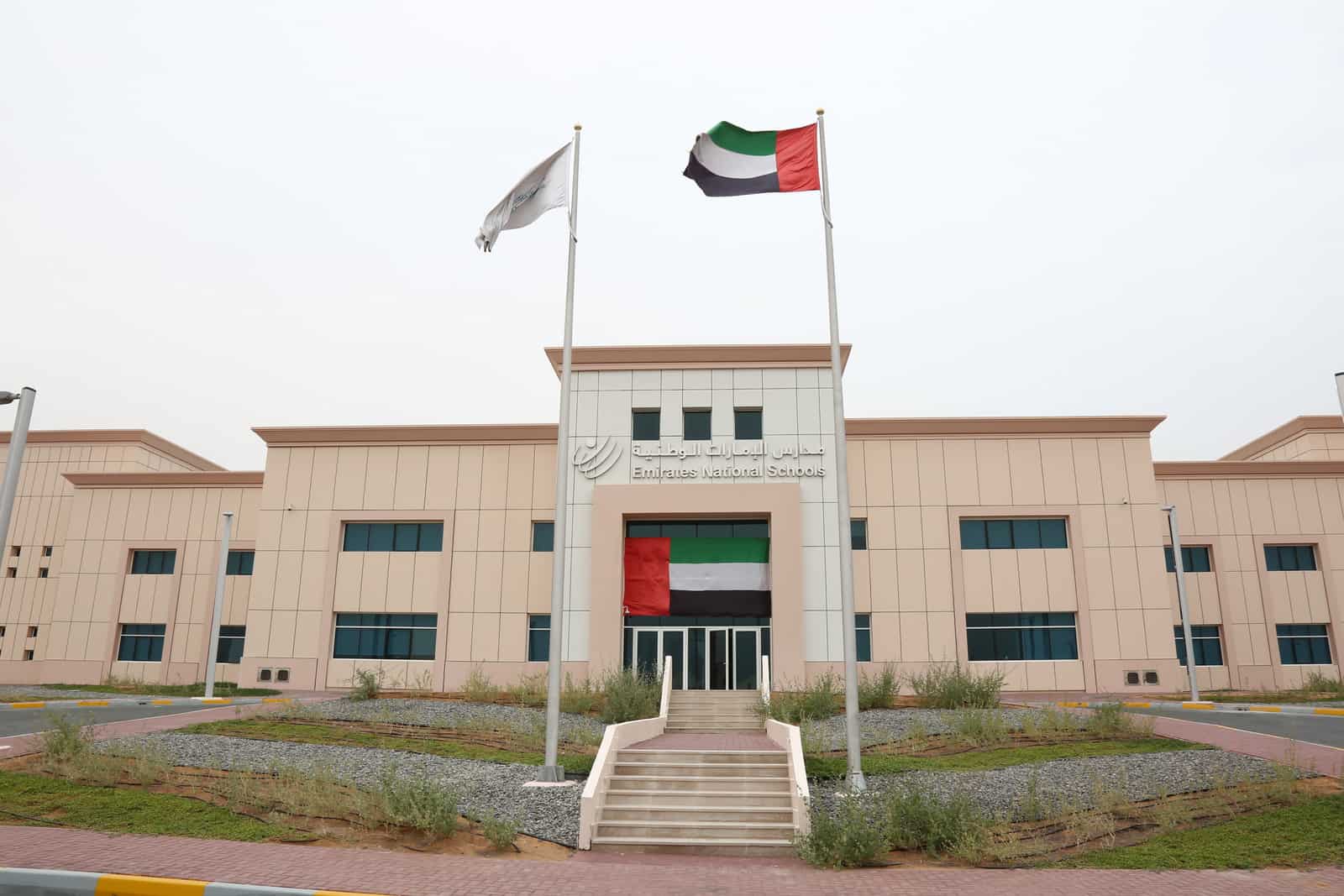 The Emirates National School in Ras Al Khaimah.
The Emirates National School in Ras Al Khaimah.
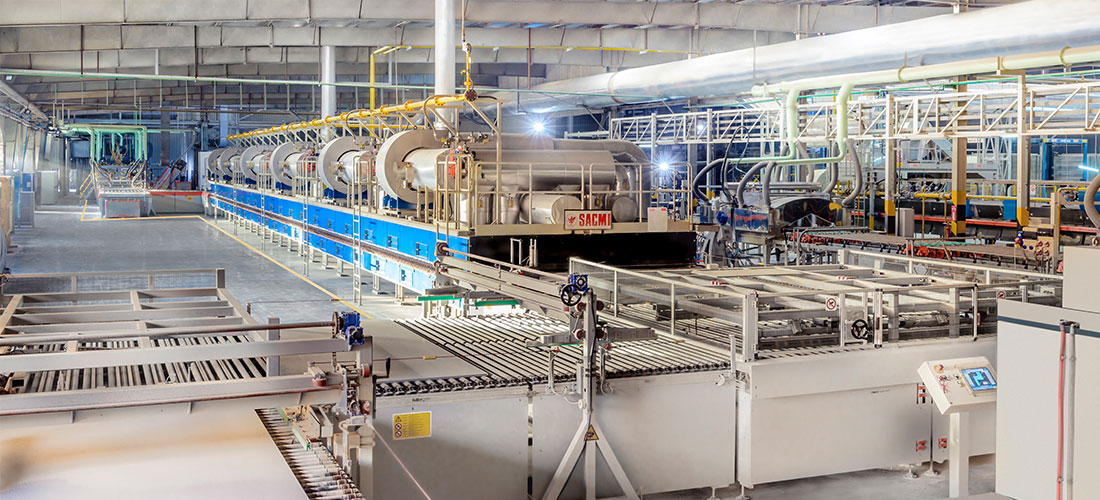 The tiles plant at the RAK Ceramics factory.
Specialising in ceramic and gres porcelain wall and floor tiles and sanitaryware, the company is a pioneer in hi-tech innovations and uses a wide range of technologies at the company’s plants, including digital printing and anti-microbial technology. It is also committed to practicing environmental stewardship throughout its manufacturing chain – from product design and efficient operations processes – and to playing an active role in building a better community by enhancing the surrounding environment.
Other major companies include the pharmaceutical manufacturer Julphar, which is one of the largest pharmaceutical manufacturers in the Middle East and Africa and one of the leading producers of insulin in the world. Established in 1980 under the guidance of Sheikh Saqr bin Mohammed Al Qasimi, the company employs more than 5,000 people and delivers high quality, innovative and affordable healthcare solutions to customers around the world.
It is tourism, however, that is arguably the emirate’s greatest recent success story. Since the establishment of the Ras Al Khaimah Tourism Development Authority (RAK TDA) in 2011, Ras Al Khaimah has become the fastest emerging tourism destination in the region. The emirate has witnessed a significant growth in overall visitor arrivals, welcoming almost 1.2 million visitors in 2019. Central to this success has been the emirate’s diverse landscape. Its rugged beauty, its lush mangroves and golden coastline have lured people to the area for thousands of years and have proven to be its greatest assets.
Standing tall at the heart of everything lies Jebel Jais, the UAE’s highest mountain. Over the past years, Ras Al Khaimah Tourism Development Authority has unveiled a series of exciting sustainable adventure projects on Jebel Jais, cementing its standing as the adventure hub of the Middle East. The Jais Adventure Peak is a gateway to attractions such as the Jebel Jais Viewing Deck Park, the Jebel Jais Flight: The World’s Longest Zipline, the Jais Sky Tour and the Jais Sky Maze. It has become a focal point for tourism development and has acted as a catalyst for improvement and expansion. An adventure park, hiking trails, rock climbing, the Middle East’s first commercial via ferrata, as well as Bear Grylls Explorers Camp with its regional debut on Jebel Jais, offering the world’s first Bear Grylls Branded accommodation, and the highest restaurant in the UAE (1484 by Puro), have all contributed to the diversification of the emirate’s tourism sector. In doing so, they have helped to raise the bar in terms of experience and adventure.
The tiles plant at the RAK Ceramics factory.
Specialising in ceramic and gres porcelain wall and floor tiles and sanitaryware, the company is a pioneer in hi-tech innovations and uses a wide range of technologies at the company’s plants, including digital printing and anti-microbial technology. It is also committed to practicing environmental stewardship throughout its manufacturing chain – from product design and efficient operations processes – and to playing an active role in building a better community by enhancing the surrounding environment.
Other major companies include the pharmaceutical manufacturer Julphar, which is one of the largest pharmaceutical manufacturers in the Middle East and Africa and one of the leading producers of insulin in the world. Established in 1980 under the guidance of Sheikh Saqr bin Mohammed Al Qasimi, the company employs more than 5,000 people and delivers high quality, innovative and affordable healthcare solutions to customers around the world.
It is tourism, however, that is arguably the emirate’s greatest recent success story. Since the establishment of the Ras Al Khaimah Tourism Development Authority (RAK TDA) in 2011, Ras Al Khaimah has become the fastest emerging tourism destination in the region. The emirate has witnessed a significant growth in overall visitor arrivals, welcoming almost 1.2 million visitors in 2019. Central to this success has been the emirate’s diverse landscape. Its rugged beauty, its lush mangroves and golden coastline have lured people to the area for thousands of years and have proven to be its greatest assets.
Standing tall at the heart of everything lies Jebel Jais, the UAE’s highest mountain. Over the past years, Ras Al Khaimah Tourism Development Authority has unveiled a series of exciting sustainable adventure projects on Jebel Jais, cementing its standing as the adventure hub of the Middle East. The Jais Adventure Peak is a gateway to attractions such as the Jebel Jais Viewing Deck Park, the Jebel Jais Flight: The World’s Longest Zipline, the Jais Sky Tour and the Jais Sky Maze. It has become a focal point for tourism development and has acted as a catalyst for improvement and expansion. An adventure park, hiking trails, rock climbing, the Middle East’s first commercial via ferrata, as well as Bear Grylls Explorers Camp with its regional debut on Jebel Jais, offering the world’s first Bear Grylls Branded accommodation, and the highest restaurant in the UAE (1484 by Puro), have all contributed to the diversification of the emirate’s tourism sector. In doing so, they have helped to raise the bar in terms of experience and adventure.
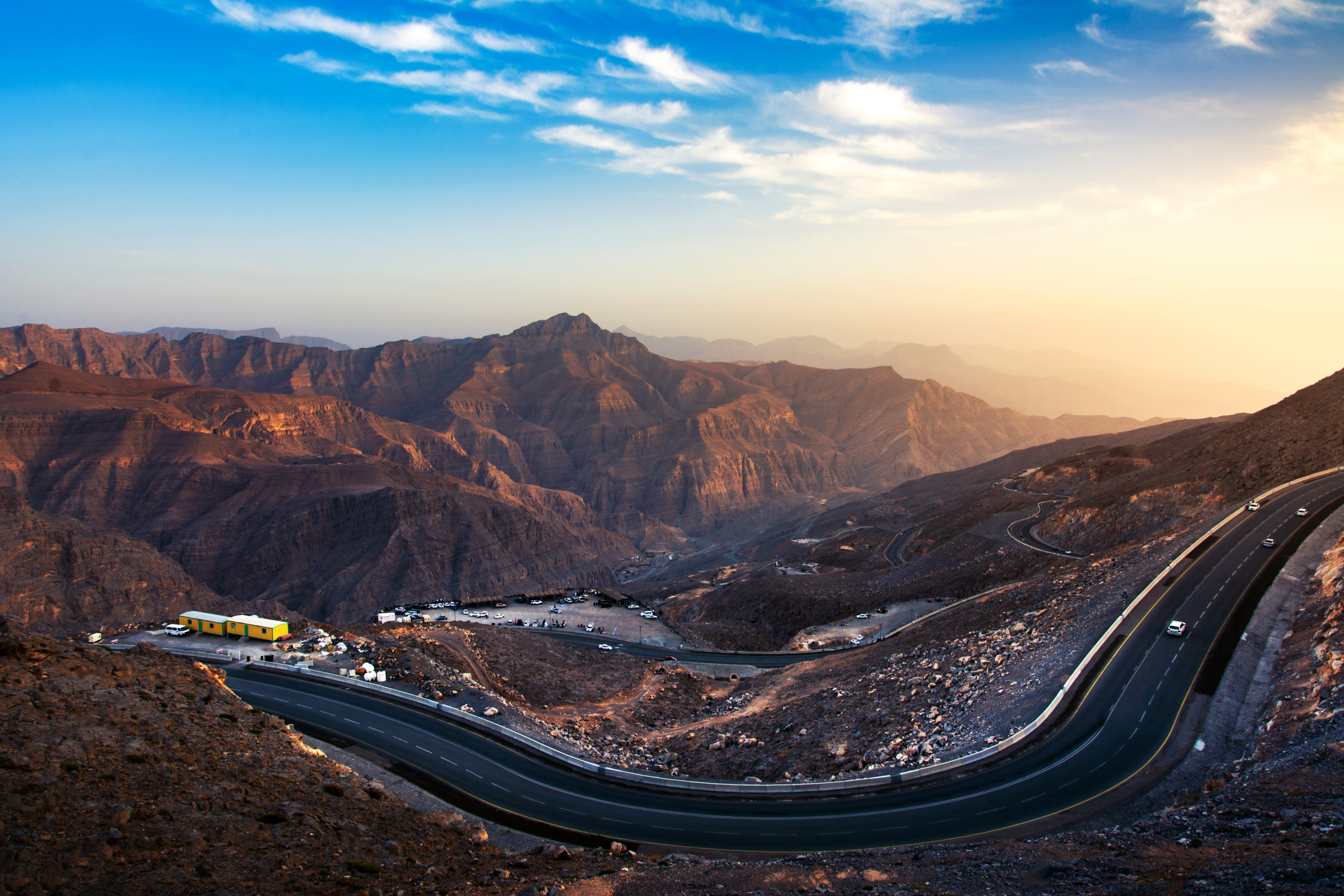 Jebel Jais mountain range
All of this investment has paid off, not only in terms of visitor numbers, but in terms of recognition too. For two years in a row Ras Al Khaimah has been named the GCC’s Gulf Tourism Capital and it was the first city in the world to receive both the prestigious ‘Safeguard Assurance’ Label from Bureau Veritas and the World Travel and Tourism Council Safe Travels Stamp. It’s all a far cry from 1960, when not a single hotel existed in Ras Al Khaimah. Even up until the 1980s there were only a handful of hotels, but that has changed dramatically in recent years. In the past ten years, the emirate has witnessed an upsurge in development, reaching approximately fifty hotels in 2021 and many more in the pipeline. That development has included Al Marjan Island, which extends 4.5 kilometres into the sea and covers an area of 2.7 million square metres, and Ras Al Khaimah’s iconic luxury destination, the Waldorf Astoria, located in Al Hamra Village.
For centuries, the emirate’s primary industries were pearling, fishing and farming. Modern initiatives such as Suwaidi Pearls, established by Abdulla Al Suwaidi in 2005, seek to revive a tradition that has long since ceased to be a viable means of living. Agriculture, however, remains an important economic activity, with Ras Al Khaimah one of the UAE’s main areas of agricultural production. Throughout much of its history the emirate was a net exporter of produce, especially for the Kingdom of Hormuz, which relied extensively on Ras Al Khaimah’s palm gardens and its harvest of dates, oranges and lemons. Portuguese Julfar lemons also took their name from the emirate’s medieval port. The emirate has continued to invest in agriculture in the modern era, beginning with the Agricultural Trials Station at Digdaga.
As early as 1955, Ras Al Khaimah sought to increase agricultural productivity by investing in an experimental farm. Although those living along the coast and within the emirate’s palm gardens had maintained a high degree of agricultural productivity for centuries, very few crops were cultivated during the decades prior to the union. In an effort to stimulate agricultural production and to introduce new methods of farming, the Agricultural Trials Station was established, with a school added soon after. Aubrey von Ollenbach, the Government of Bahrain’s director of agriculture, was chosen to survey the area in the mid-1950s and found it to be suitable for experimentation. Robin Huntington, a former soldier, was then appointed to run the station, remaining there until 1961.
The station proved to be extremely successful. “Excellent crops of well grown tomatoes, cabbages, lettuce, onions and other vegetables were being grown, as well as flourishing plots of lucerne (‘jet’) for fodder,” wrote J C Eyre, an agricultural advisor for the Middle East Development Division, in 1957. “These plots are providing a very good demonstration to local cultivators of what can be done, provided sufficient care is taken over details. Vegetable seedlings of crops such as cabbage and tomato could be grown on the station for distribution to cultivators until they become sufficiently experienced themselves.”
The farm and the agricultural school helped to revolutionise agriculture in Ras Al Khaimah and grew to include offices, a veterinary clinic and a mechanical workshop, as well as poultry houses for 700 imported hens. There were also herds of red Sindhi cattle and Damascus goats. “Simple trials on one or two crops such as tomatoes and onions should be made next winter season to find out if the amount of water required can be reduced,” wrote Eyre. “Mr van Ollenbach will be able to advise on how a simple trial should be carried out. The trials may show that larger areas can be cultivated with the water available and this will be important for local cultivators.”
Eyre also proposed that the school be restricted to about eight boys. “The school will supply an urgent need, but the boys should be carefully selected from families likely to develop their lands,” he wrote. “The boys will assist in cultivating the plots at the agricultural station at Ras Al Khaimah, and it is most desirable that the boys should also be given some experience in managing the cattle.”
The farm and agricultural school remained operational until it was taken over by the Ministry of Agriculture and Fisheries in 1972. It is now on the grounds of the Ministry of Environment and Climate Change headquarters, where emphasis has been placed on a national system for sustainable agriculture. With food security a national priority, emphasis has been placed on water preservation, hydroponics, organic farming, and the promotion, adoption and installation of modern irrigation systems. Such initiatives are integral to the UAE’s food security initiatives, which have included efforts to increase land productivity, reduce water usage, and invest in organics and aquaculture.
Jebel Jais mountain range
All of this investment has paid off, not only in terms of visitor numbers, but in terms of recognition too. For two years in a row Ras Al Khaimah has been named the GCC’s Gulf Tourism Capital and it was the first city in the world to receive both the prestigious ‘Safeguard Assurance’ Label from Bureau Veritas and the World Travel and Tourism Council Safe Travels Stamp. It’s all a far cry from 1960, when not a single hotel existed in Ras Al Khaimah. Even up until the 1980s there were only a handful of hotels, but that has changed dramatically in recent years. In the past ten years, the emirate has witnessed an upsurge in development, reaching approximately fifty hotels in 2021 and many more in the pipeline. That development has included Al Marjan Island, which extends 4.5 kilometres into the sea and covers an area of 2.7 million square metres, and Ras Al Khaimah’s iconic luxury destination, the Waldorf Astoria, located in Al Hamra Village.
For centuries, the emirate’s primary industries were pearling, fishing and farming. Modern initiatives such as Suwaidi Pearls, established by Abdulla Al Suwaidi in 2005, seek to revive a tradition that has long since ceased to be a viable means of living. Agriculture, however, remains an important economic activity, with Ras Al Khaimah one of the UAE’s main areas of agricultural production. Throughout much of its history the emirate was a net exporter of produce, especially for the Kingdom of Hormuz, which relied extensively on Ras Al Khaimah’s palm gardens and its harvest of dates, oranges and lemons. Portuguese Julfar lemons also took their name from the emirate’s medieval port. The emirate has continued to invest in agriculture in the modern era, beginning with the Agricultural Trials Station at Digdaga.
As early as 1955, Ras Al Khaimah sought to increase agricultural productivity by investing in an experimental farm. Although those living along the coast and within the emirate’s palm gardens had maintained a high degree of agricultural productivity for centuries, very few crops were cultivated during the decades prior to the union. In an effort to stimulate agricultural production and to introduce new methods of farming, the Agricultural Trials Station was established, with a school added soon after. Aubrey von Ollenbach, the Government of Bahrain’s director of agriculture, was chosen to survey the area in the mid-1950s and found it to be suitable for experimentation. Robin Huntington, a former soldier, was then appointed to run the station, remaining there until 1961.
The station proved to be extremely successful. “Excellent crops of well grown tomatoes, cabbages, lettuce, onions and other vegetables were being grown, as well as flourishing plots of lucerne (‘jet’) for fodder,” wrote J C Eyre, an agricultural advisor for the Middle East Development Division, in 1957. “These plots are providing a very good demonstration to local cultivators of what can be done, provided sufficient care is taken over details. Vegetable seedlings of crops such as cabbage and tomato could be grown on the station for distribution to cultivators until they become sufficiently experienced themselves.”
The farm and the agricultural school helped to revolutionise agriculture in Ras Al Khaimah and grew to include offices, a veterinary clinic and a mechanical workshop, as well as poultry houses for 700 imported hens. There were also herds of red Sindhi cattle and Damascus goats. “Simple trials on one or two crops such as tomatoes and onions should be made next winter season to find out if the amount of water required can be reduced,” wrote Eyre. “Mr van Ollenbach will be able to advise on how a simple trial should be carried out. The trials may show that larger areas can be cultivated with the water available and this will be important for local cultivators.”
Eyre also proposed that the school be restricted to about eight boys. “The school will supply an urgent need, but the boys should be carefully selected from families likely to develop their lands,” he wrote. “The boys will assist in cultivating the plots at the agricultural station at Ras Al Khaimah, and it is most desirable that the boys should also be given some experience in managing the cattle.”
The farm and agricultural school remained operational until it was taken over by the Ministry of Agriculture and Fisheries in 1972. It is now on the grounds of the Ministry of Environment and Climate Change headquarters, where emphasis has been placed on a national system for sustainable agriculture. With food security a national priority, emphasis has been placed on water preservation, hydroponics, organic farming, and the promotion, adoption and installation of modern irrigation systems. Such initiatives are integral to the UAE’s food security initiatives, which have included efforts to increase land productivity, reduce water usage, and invest in organics and aquaculture.
